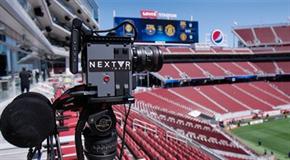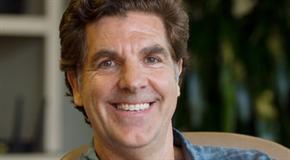Features
What’s Next For VR

There has been much talk about VR and yet few consumers know about it and fewer have the hardware. NextVR has strong ties to professional sports, especially with the Golden State Warriors. It also boasts a proprietary 3D VR audio platform that will be implemented at concerts.
We asked NextVR Executive Chairman Brad Allen about how his company will expand its presence in the near future.
Surprisingly not a lot of people know about VR still.
What’s incredible about VR is the interest level. I’ve never seen it in my career and I’ve been in business for 30 years. I was formerly on the banking side of things. There seems to be a lot of knowledge from the corporate side, globally, but 99 percent of consumers have never even seen VR. They’re hearing about it. But it’s going to have a profound effect on the way we experience events, whether it’s sports or music.
It’s going to bring us closer to our favorite artist or band like never before. If you have a friend in the band or whatever, you get to stand on the side of the stage. This is going to allow the general public to buy that virtual ticket to be on the stage, in front of it, in the crowd looking back at the stage. Backstage. I mean, let your imagination run.
And it’s going to be available globally! That’s what’s incredible. Everybody has a mobile phone and a lot of the experiences now, like Gear VR, are all mobile, which everyone has.
Considering your relationship with the NBA and college basketball, how many arena GMs will be introduced to NextVR in the coming year?
I’d say the majority of them. Fortunately we have a lot of relationships and if you just want to talk about sports, around the leagues, broadcasters and rights holders, then the arena owners with teams have a relationship with us already. We have a special relationship with the Warriors because Peter Guber is one of our shareholders and a great partner, but we have been contacted by a number of other teams.

And this goes throughout the world of sports, whether it’s cricket or Premier League or NBA, NFL or NHL. Everybody wants to see what their sport looks like in virtual reality. I’ve been fortunate to be able to sit courtside at an NBA game – which is arguably the best seat in sports. It’s a very intimate experience. Having a VR camera on the scorer’s table allows you to experience the game as if you were sitting there. The Warriors have been sold out for years but this allows you to have that seat.
There are 300 million fans in China but 299.9 million won’t ever get to a game or buy a seat. This way, they will. The same is true for music. Check out our Coldplay experience; it’s on our app. One of our shareholders is Madison Square Garden. We haven’t done anything with MSG yet, but will soon. They’re investing in our company because they see the future: being able to bring the global fanbase to this iconic arena. Arenas around the world are looking at this, as well as arenas that haven’t even been built yet. They’re wiring them for virtual reality to bring the fanbase in. There are only so many seats.
It’s one thing to provide VR to a sold-out event but how do you handle a half-sold house?
It can be pay-per-view or, if it’s like a Live Nation event, which has 25,000 live events a year, there would be a subscription model. If shows aren’t selling out, you can geofence around a certain area to not allow people, locally, to watch it. It’s like the blackouts they used to have for the NFL. We had to do this with some of our events. We have a partnership with Fox Sports. Their rights extend to the U.S. We have to geofence around where their rights are held.
How will you continue to introduce your brand to the consumer?
A lot of our focus has been around partnerships with all of the major content holders, rights owners, whatever. As you said, maybe one out of 100 consumers may know about VR but it seems 99 percent of the corporates around the world know about VR and have a strategy. It’s still early days but we hear Samsung has 1 million Gear VR out there.
There will be 10 million out by the end of the year. But we haven’t gone out to promote our brand as it were. All of the early adopters know about NextVR because of our live streaming. You see our numbers increasing and everybody gets excited. But we do have a strategy about marketing our brand and a lot has to do with our partners. When we did the Kentucky Derby with NBC Sports, they said, on air, “If you would like to watch this in virtual reality, download the NextVR app and you’ll be transported to the track.” We’re leveraging the big brands we’re working with.
Again, I’ve showed this to about 100 people (outside the office) in a month and about 50 percent ask how much does it cost and where it can be bought. Then they show it to everybody else at the table. It’s been a viral experience.
Again, it’s not like anything I’ve ever seen. It’s visual, and you’re talking about passionate NBA fans or NFL fans. Manchester United has 650 million reported fans around the world so they all want to be closer to the action. I do too! I’m a passionate sports fan, you have your favorite artists, and you can feel like you’re courtside or onstage. It’s incredible; it’s not like anything we’ve ever seen. We’ve gone from radio to television to VR.
It sells itself and it’s only going to get better. As Peter Guber says, we’re not at the beginning; we are at the beginning of the beginning. ? Anything else? Yes. The goggles right now are heavy. They get hot. They’re goofy looking. It’s a given that technology will improve.
The goggles will become glasses. They already are – the new LG glasses have come out. They weigh 130 grams as opposed to GearVR, which weighs a lot. The resolution will be full HD; right now it’s pixelated. This isn’t five years down the road; this is happening now. In the next six to 24 months you’ll see the bulk of this change and that’s when we’ll go mass-market. Plus, you have the biggest companies in the world – Amazon, Apple, Facebook, Google, Microsoft and a whole bunch of others – building for VR. It’s the most fun thing I’ve ever been involved in and I’m having a great time, if you can’t tell.